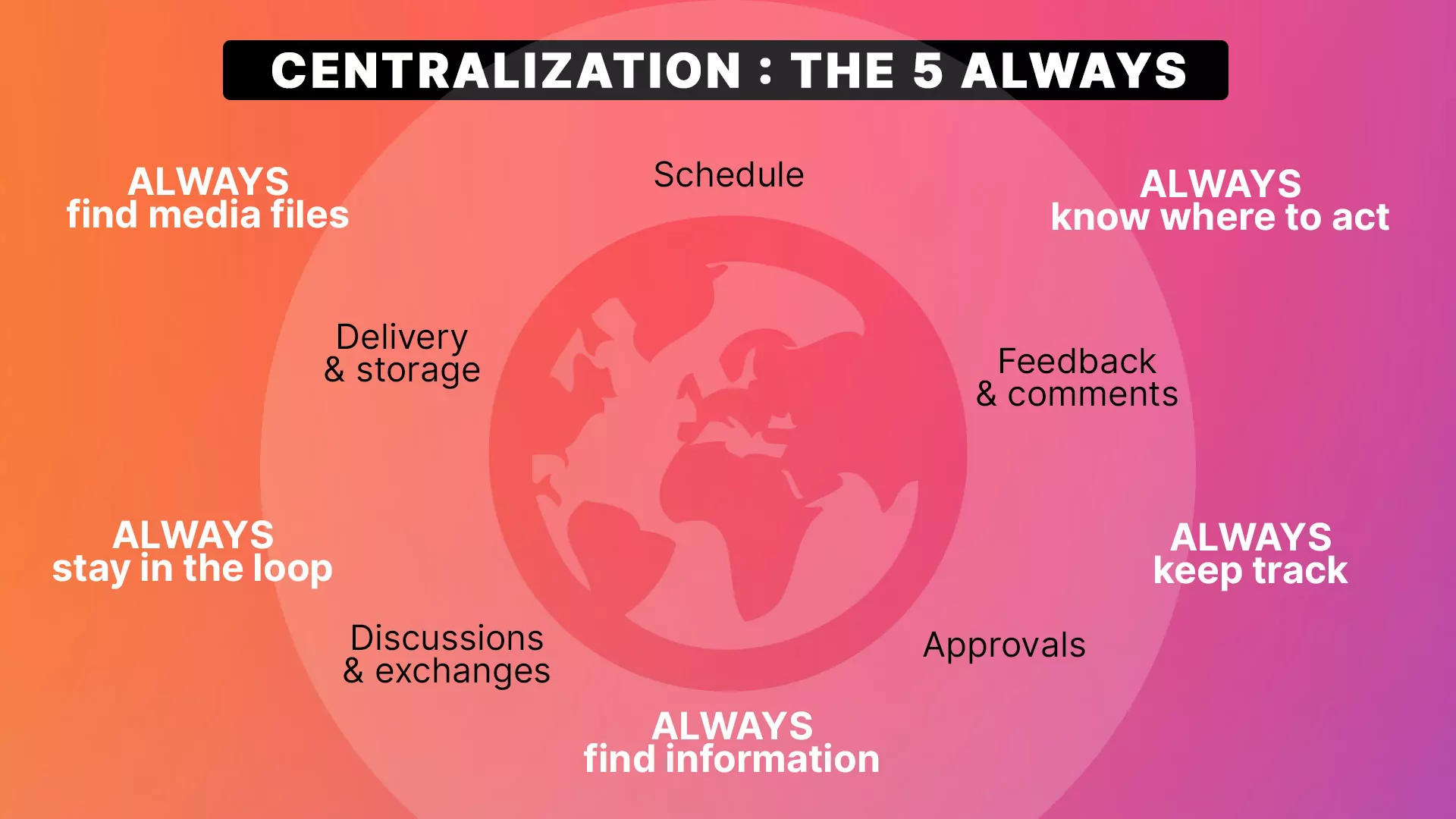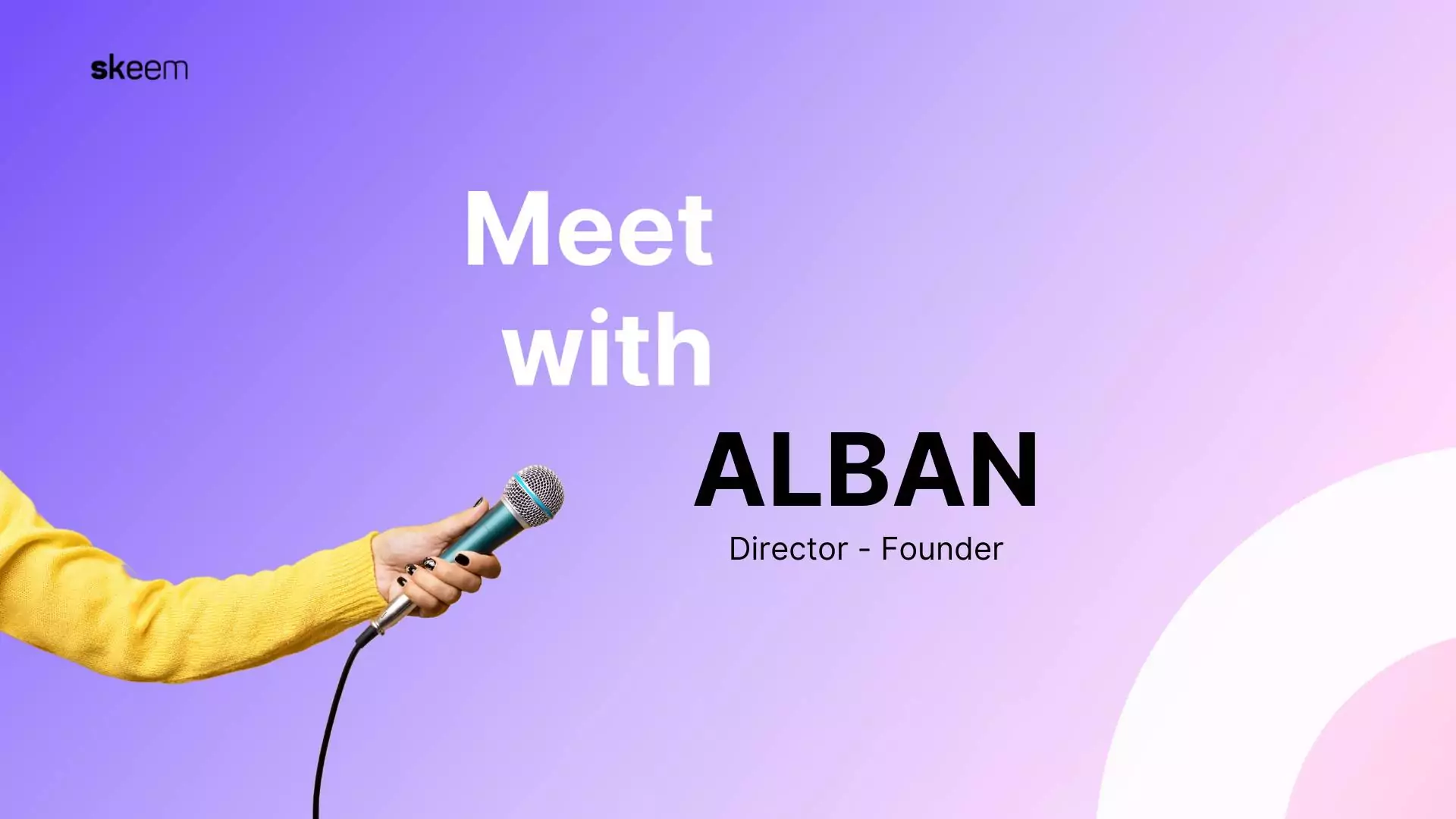Digital communication, in sharing mode. Producing content requires tools and methods. Here, everything is shared! Experiences, news, tips and articles to make your production easier.
5 benefits of data centralization for video projects

- Always know where to act
- Always keep track
- Always have information at hand
- Always stay in the loop
- Always find the media
The availability and accuracy of information facilitates the achievement of objectives and cooperation between customer and creative teams. This is why, for optimum efficiency, it has become essential to centralize information.
This means that all data (in the broadest sense of the term: data, media, messages) must be gathered on a central server and made available to everyone, at any time and anywhere in the world.
This centralization of data conditions all structuring decisions and the success of a video project.
The benefits of data centralization can be summed up in 5 key points: the 5 ALWAYS
Always know where to act
One of the major issues for customer and creative teams is knowing where and how to act. By nature, a customer is not an audiovisual professional, and may not know the exact production stages or workflow of a video project. This is particularly true at the start-up stage, when methods and the associated retro planning are defined. But it’s essential to take it into account throughout the entire process, and to do so dynamically.
That’s why it’s essential to facilitate each and every one of the players involved in the success of a video project, throughout the entire production process. These interventions are numerous, but can be grouped into 4 categories:
- Content and information sharing stages
- Transmission of deliverables (video and other media)
- Feedback stages
- Validation steps.
These are essential, structuring stages. Their clarity avoids a lot of endless exchanges, forgetfulness, reminders and tension. And more than that, a clear vision of the process brings confidence and goodwill!
So how does centralizing data help you know where to act?
When we think of data centralization, we often think of data and files. In a nutshell, centralization can be summed up as a synchronized Drive from which to draw. Centralization is much more than that, because you can also centralize processes and methods.
In the case of a video project, this means sharing a clear vision of the production through an online schedule. The schedule then becomes the control center for all production. It provides the customer team with all the key information for the duration of the project.
Here are a few concrete examples. The schedule can be used to indicate when :
- Share graphic guidelines at the start of production
- Provide feedback on a selection of shooting locations
- Make corrections to V1
- Validate before moving on to the next step
By centralizing each stage of the planning process, we can guide not only our customers, but also all participants, so that they always know where and how to act. You avoid incessant questions from lost employees. The production is professional and pleasant.
Always keep track
We’ll be quicker on this point – it’s a simple one: historicization eases relationships.
Of course, almost everyone starts a video project in a positive frame of mind, full of goodwill. However, all professionals also know, and in some cases have already experienced, that smooth project management depends on mutual understanding and good communication. We are human beings, and we absorb information through the prism of our differences. Sometimes this leads to conflicting interpretations.
It is therefore essential that communication is both precise in content and precise in time.
- To be precise in its content, it has to be written down, because we are never as precise as when we know that our tracks commit us.
- To be accurate over time, it must be dated and integrated into a history.
So how does centralization help you keep track?
All centralization solutions and collaborative platforms use time-stamped systems to record the dynamics of exchanges and collaboration. This makes it easy to find out who said what and when.
The centralization of data thus accentuates the benefits of this shared communication in the eyes of all. Not only does it prevent certain excesses, it also enables discussions to be held, if need be, on the unquestionable basis of a neutral arbitrator: the platform.
Always have information at hand
It’s on this theme that centralization is most often emphasized.
Easy to understand!
If data is stored and secured in an accessible, known location, then finding the information you’re looking for when you need it becomes quick and painless. And these pains speak to everyone. Who hasn’t felt like screaming after endless fruitless searches, in emails or sms, cursing the whole world for being so unorganized…
As part of video project management, data centralization makes it possible to gather and visually organize different types of information:
- Customer requests and briefings
- Production contacts
- The material needed to make the film (photos, images, logos, graphics, video, etc.)
- Standard production documents (script, storyboard, work plan, service sheet, etc.)
- Customer information contained in messages (choices, changes, directions)
- Customer feedback on deliverables (visuals, music, voice-overs, editing, etc.)
- Media exchanged or delivered
In this respect, data centralization provides priceless comfort throughout the production process.
Always stay in the loop
You’re always up to date! One of the daily challenges of video project management is to ensure that all participants receive the information they need in good time. At the same time, it’s useful to know when participants have performed the action expected of them. Firstly, it’s reassuring, but it also saves time, since data is centralized and updated in real time. In this way, information is available as soon as it is generated, without delay and systematically. No more forgetting or delaying to send information.
So how does centralized data help you stay on top of things?
In addition to the fact that by simply logging in, any project participant can actively retrieve information, most digital centralization solutions work with an automated email notification system. These alerts concern :
- File uploads and downloads
- Messages and discussions
- Reviewing and comments on media (video, image, audio, text…)
- Validations
Centralization therefore also concerns alerts and automatic information systems. This is quite relaxing and allows you to focus on your core business and high value-added tasks.
Always find the media
This aspect of centralization relates more directly to deliverables. Everyone involved in a project knows the unpleasant sensation of searching for the latest version, or having to resend media that has already been delivered, lost or inaccessible behind an obsolete link.
Media centralization provides a link to an identified area that is always accessible until the end of the project. This applies to all video project deliverables:
- Scripts, moodboards, storyboards…
- Graphic proposals
- The different mounting versions
- Entertainment
- The music
- Voice-over recordings
- Masters
The 5 ALWAYS show just how much data centralization simplifies, accelerates and improves video production workflows.
But for it to be complete and effective, it needs to be integrated, right from the start of the video project, by considering the need for communication between the creative and client teams at every stage of production.

